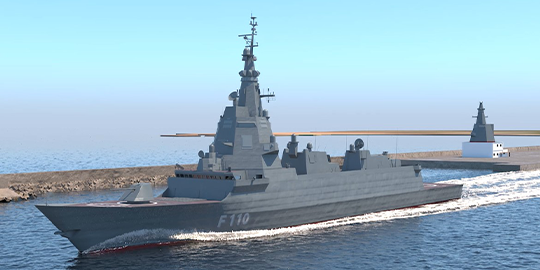
F110 Frigate: technological superiority in each mission
It will escort and protect the fleet, but it will also operate independently in highly hostile environments. Indra is preparing the future F110 frigate to achieve supremacy in any scenario and against any adversary
United States, Australia, South Korea, United Kingdom. The most powerful navies in the world are working to renew their fleets with a multi-role frigate suited to handle any mission: air, surface, anti-submarine, etc.
With a length of 145 meters, an 18-meter beam and displacement of 6,100 tons, the F110 is one of the vessels that best fits in this new multi-purpose vessel concept with a high offensive and survival capability.
One of the most innovative elements that it incorporates in its design is the integrated mast that rises over the control bridge. In the words of the Naval Programs Director at Indra, Carmela Barbero Arrabé, the mast "minimizes the radar section so that F110 operates with maximum stealth, making it difficult for the adversary to detect its presence.”
But under the skin of this superstructure there is a complete range of state-of-the-art sensors that will guarantee the superiority of the F110:
- The primary S-band radar that Indra is developing with the American firm Lockheed Martin will provide a capability for aerial surveillance and support anti-aircraft combat at the highest level.
It is a solid-state radar based on gallium nitride (GaN), the most advanced and efficient technology to generate the required power levels with high reliability.
Completely digitalized and built with hundreds of small independent blocks, Barbero explains that “it will work as if the F110 had multiple radars working in a coordinated way. This fact will give the F110 a powerful multi-function capability to combine tasks: it will operate as a long-range radar and integrate missile control, while setting the tracking on multiple targets, all at the same time. Barbero says that "the possibilities offered by the new system will provide the frigate with capabilities far superior to other vessels in its class."
- To support surface combat and helicopter landing on deck, the frigate will have the Prisma 25X radar.
Its four flat facets, which replace the old rotating radar antenna, contribute to its stealth. The solid state active electronically scanned array (AESA) technology, together with its incredible processability, will allow the beam of each of its facets to be controlled with great agility and in an independent manner.
These features make it possible to explore a space with enormous freedom, precision and a high refresh rate. It is a multi-function radar, so operators “will be able to monitor the movements of surface targets and aircraft flying at low altitude while tracking the presence of submarine periscopes, support surface combat and support the helicopter landing on deck; there are no limitations, ”says Barbero.
- The IFF system will identify friendly and enemy aircraft to avoid the much-feared friendly fire, one of the most frequent causes of casualties in conflict. “This sensor will be based on state-of-the-art solid state active electronically scanned array (AESA) technology (GaN). It incorporates multiple military and civil identification modes and an additional passive identification system known as ADS-B”, the Naval Programs Director at Indra went on to explain in detail.
- As for electronic defense systems, Indra technology will track the communications band and the radar band. “The system will detect and identify any nearby vessel, submarine or aerial or land platform and it will be prepared to counteract multiple threats simultaneously. It will prevent the enemy from detecting its position. It will make its communications difficult. It will blind the missile guidance systems”, sums up the Indra Director.
It will use fully digitalized interferometry techniques, capable of combining the signals collected by different antennas and sensors to generate a much more precise situational awareness. Barbero explains that, in addition, "new algorithms based on artificial intelligence and additional hardware to collect raw data massively and identify the most complex signals" will be incorporated.
It will also use new super-resolution techniques and algorithms, capable of discovering enemy communications that try go unnoticed by using the radio spectrum in an expanded way (Direct Sequence Spread Spectrum, DSS).
- Finally, the system will provide an impressive protection capacity against sea-skimming missiles and swarms of vessels, which typically attempt to impact the waterline of vessels.
“The IRST i110, which is how we call this advanced system that we developed with Tecnobit, represents a technological leap of enormous magnitude. Through a fixed system, without moving parts, it offers simultaneous 360º surveillance, at all times, and covers the long and short- range visible and infrared spectrum. It also has telemetry capability. Its mission is to detect, recognize and identify any object likely to represent a threat.”

Add new comment